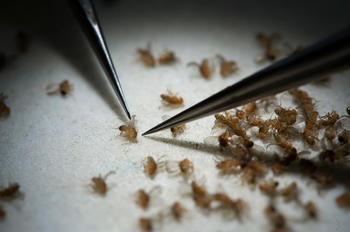Life without the Neurobeachin Protein
Scientists at Freie Universität, Universität Hohenheim, and Katholieke Universiteit Leuven Breed Fruit Flies for First Time without the Neurobeachin Protein and Facilitate Study of Nervous Disorders in Humans
Dec 20, 2012
Through experiments on the brain of the common fruit fly, Drosophila, researchers have advanced the study of brain function and human disease.
Image Credit: Bernd Wannenmacher
In experiments on the brain of the fruit fly Drosophila, scientists at Freie Universität Berlin have advanced the research on brain function and diseases in humans. Neuroscientists in the Emmy Noether Junior Research Group "Biological Memory Systems" headed by Dr. Martin Schwärzel and based at Freie Universität succeeded in breeding fruit flies without the neurobeachin protein. Among other things, BEACH proteins affect the development and function of the brain in animals and humans. The results were published in the most recent issue of The Journal of Neurosciences. In the future such animal models could be of particular importance for the understanding of certain diseases in humans, such as autism. Scientists from the University of Hohenheim and the Belgian Katholieke Universiteit Leuven were also involved.
Up to now there were no animal models suitable for understanding the significance of neurobeachin proteins in the functioning of the nervous system, for example in memory formation. Mice that are lacking the neurobeachin protein die shortly after birth. Fruit flies, on the other hand, can be alive and well without neurobeachin. The scientists also found in experiments on the flies that neurobeachin has a function in learning as the flies exhibit characteristic learning disabilities due to the absence of the protein.
The flies were also found to have a number of other abnormalities with regard to the development and function of the nervous system. Through a "genetic rescue experiment," the researchers were able to localize the distribution of these defects in the brain. The function of the lacking neurobeachin gene was reintroduced in certain areas of the nervous system. With this procedure, the researchers were able to show, among other things, that certain features of the neurobeachin protein in flies and mice are identical.
Literature
Karolien Volders, Sabrina Scholz, Jan R. Slabbaert, Anja C. Nagel, Patrik Verstreken, John W. M. Creemers, Patrick Callaerts, and Martin Schwärzel: "Drosophila rugose Is a Functional Homolog of Mammalian Neurobeachin and Affects Synaptic Architecture, Brain Morphology, and Associative Learning." The Journal of Neuroscience 32 (43): 24 October 2012. http://www.jneurosci.org/content/32/43/15193.full

